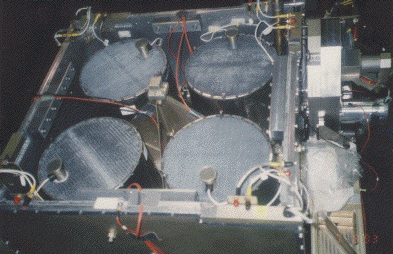About RXTE
The HEXTE
The HEXTE consists of two clusters each containing four phoswich scintillation detectors. Each cluster can ``rock'' (beamswitch) along mutually orthogonal directions to provide background measurements 1.5 or 3.0 degrees away from the source every 16 to 128 s. Automatic gain control is provided by using a 241Am radioactive source mounted in each detector's field of view. The HEXTE's basic properties are:
- Energy range: 15 - 250 keV
- Energy resolution: 15% at 60 keV
- Time sampling: 8 microsecond
- Field of view: 1 degree FWHM
- Detectors: 2 clusters of 4 NaI/CsI scintillation counters
- Collecting area: 2 times 800 cm^2
- Sensitivity: 1 Crab = 360 count/s per HEXTE cluster
- Background: 50 count/s per HEXTE cluster
Events detected by HEXTE will be processed on board by its own data system before insertion into the telemetry stream at an average data rate of 5 kbit/s. Data products include event mode, binned spectra and light curves, and a burst-triggered event buffer.
The HEXTE was designed and built by the Center for Astrophysics & Space Sciences (CASS) at the University of California, San Diego. For more information, see the HEXTE home page at UCSD.
The HEXTE principal investigator is Dr. Richard E. Rothschild.



